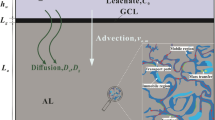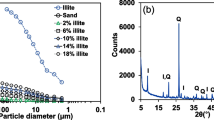Abstract
The migration of heavy metals and other contaminants through soil strata can lead to variable geo-environmental questions resulting in soil and groundwater contamination, which may affect the nearby land and water ecosystem. Comparative batch adsorption tests were conducted for both raw and amended clay soil. With AI, it was found that the latter shows an effective removal, i.e., above 90%. The physical and numerical modeling studies on solute transport were conducted to assess the hexavalent chromium attenuation potency of the locally obtainable amended clay soil mixed with neem (Azadiracta indica (AI)), which is used as primary liner for waste containment structures. The physical modeling performed in the laboratory in the horizontal migration tank study tends to show a similar approach with a graph plotted with the HYDRUS-3D data. Langmuir and Freundlich isotherms based on the batch experiments were plotted, with the Langmuir model fitting the best (RMSE = 1.38, R2 = 0.99). Breakthrough curves predicted by the HYDRUS-3D numerical model exhibited that the liner is getting saturated after approximately 38 years.
Access this chapter
Tax calculation will be finalised at checkout
Purchases are for personal use only
Similar content being viewed by others
Abbreviations
- AAS:
-
Atomic absorption spectroscopy
- AI:
-
Azadiracta indica
- Al:
-
Aluminum
- As:
-
Arsenic
- b:
-
Constant related to the free energy of adsorption and a measure of the affinity of binding sites (L/mg)
- BOD:
-
Biochemical oxygen demand
- BTCs:
-
Breakthrough curves
- CCME:
-
Canadian Council of Ministers of the Environment
- Cd:
-
Cadmium
- Cl-:
-
Chlorine
- COD:
-
Chemical oxygen demand
- Cr (VI):
-
Hexavalent chromium
- Cr:
-
Chromium
- Cu:
-
Copper
- Fe:
-
Iron
- Hg:
-
Mercury
- kf :
-
Adsorbent capacity (mg/Kg)
- MDD:
-
Maximum dry density
- n:
-
Adsorbent intensity (L/mg)
- Ni:
-
Nickel
- NO3−:
-
Nitrate
- Pb:
-
Lead
- PI:
-
Plasticity index
- Qmax:
-
Maximum sorption capacity at monolayer
- R2:
-
Regression co-efficient
- RMSE:
-
Root mean square
- SO4−:
-
Sulfate
- SW:
-
Solid waste
- TDS:
-
Total dissolved solids
- Zn:
-
Zinc
References
J.C. Akan, E.A. Moses, V.O. Ogugbuaja, Assessment of tannery industrial effluent from Kano metropolis, Nigeria Asian Network for Scientific Information. J. Appl. Sci. 7(19), 2788–2793 (2007)
J.C. Akan, F.I. Abdulrahman, G.A. Dimari, V.O. Ogugbuaja, Physicochemical determination of pollutants in wastewater and vegetable samples along the Jakara wastewater channel in Kano metropolis, Kano State, Nigeria. Eur. J. Sci. Res. 23(1), 122–133 (2008)
APHA-AWWA-WPCF, Standard Methods for the Examination of Water and Wastewater, 20th edn. (American Public Health Association, Washington, DC/New York, 2005)
V.O. Arief, K. Trilestari, J. Sunarso, N. Indraswati, S. Ismadji, Recent progress on biosorption of heavy metals from liquids using low cost biosorbents: Characterization, biosorption parameters and mechanism studies. Clean Soil Air Water 36, 937–962 (2008)
J.A. Barry, B.W. Karney, Z. Members, C.J. Cormier, A. Lat, Artesian landfill liner system: Optimization and numerical analysis. J. Water Resour. Plan. Manag. 124, 345–356 (1998)
C. Bhadra, S. Pal, K. Adhikari, Use of compacted clay liner for the attenuation of landfill leachate migration from a MSW site in Durgapur, West Bengal. J. Indian Chem. Soc. 95, 235–242 (2018)
C. Bhadra, S. Pal, K. Adhikari, Efficacy evaluation of chromium(VI) adsorption on clay soil blended with Azadiracta indica (Neem) and Moringa oleifera (Drum stick) seed shell. J. Indian Chem. Soc. 96, 1–5 (2019)
CCME (Canadian Council of Ministers of the Environment), Interim Canadian environmental quality criteria for contaminated sites, CCME, Winnipeg, 1991
R. Chakraborty, M. Chakraborty, A. Mitra, Infrared irradiation aided fabrication of Mn impregnated-natural bone adsorbent: Efficacy evaluation in aqueous Cr (VI) removal. J. Water Process Eng. 6, 32–41 (2015)
M. Chowdhury, M.G. Mostafa, T.K. Biswas, A.K. Saha, Treatment of leather industrial effluents by filtration and coagulation processes. Water Resour. Ind. 3, 11–22 (2013)
K. Cooman, M. Gajardo, J. Nieto, C. Bornhardt, G. Vidal, Tannery waste water characterization and toxicity effects on Daphnia Spp. Environ. Toxicol. 18, 45–51 (2003)
Council of leather export (CLE), Sponsored by Ministry of Commerce & Industry, Government of India
R. Ganesh, R.A. Ramanujam, Biological waste management of leather tannery effluents in India: Current options and further research needs. Int. J. Environ. Monit. 3, 232–237 (2009)
IS 10500, Drinking Water – Specification (Bureau of Indian Standards, New Delhi, 2012)
IS 2720: Part III: Sec 2: 1980, Test for soils: Determination of Specific Gravity of fine-grained soil
IS2720: Part 17: 1986, Methods of test for soils: Laboratory determination of permeability
S.R. Khan, M.A. Khwaja, S. Khan, G.H. Kazmi, Environmental impacts and mitigation costs of cloth and leather exports from Pakistan. Environ. Dev. Econ. 6, 383–403 (2001)
S. Pal, S.N. Mukherjee, S. Ghosh, Optimizing phenol sorption in peat by response surface method. J. Environ. Geotech. 1(3), 142–151 (2013)
S. Pal, S.N. Mukherjee, S. Ghosh, Application of HYDRUS 1D model for assessment of phenol–soil adsorption dynamics. Environ. Sci. Pollut. Res. 21(7), 5249–5261 (2014)
P. Scholl, D. Leitner, G. Kammerer, W. Loiskandl, H.-P. Kaul, G. Bodner, Root induced changes of effective 1D hydraulic properties in a soil column. Plant Soil 381, 193–213 (2014)
United States Environmental Protection Agency 2002
WHO, Guidelines for Drinking-Water Quality (World Health Organization, Geneva, 1963)
Acknowledgment
The authors express their wholehearted gratitude to the Department of Civil Engineering and Department of Earth & Environmental Studies, NIT Durgapur, and Civil Engineering Department of Heritage Institute of Technology, Kolkata, West Bengal, India, for providing all necessary supports and assistance to carry out this research. The authors also wish to convey their sincere thanks to the Director, NIT, Durgapur, West Bengal, India, for his constant encouragement throughout the study.
Author information
Authors and Affiliations
Corresponding author
Editor information
Editors and Affiliations
Rights and permissions
Copyright information
© 2023 The Author(s), under exclusive license to Springer Nature Switzerland AG
About this paper
Cite this paper
Bhadra, C., Adhikary, A., Pal, S., Adhikari, K. (2023). Modeling of Migration of Cr (VI) Contaminant Through Clay Liner Using HYDRUS-3D. In: Mazumder, D. (eds) Sustainable Advanced Technologies for Industrial Pollution Control. ATIPC 2022. Springer Proceedings in Earth and Environmental Sciences. Springer, Cham. https://doi.org/10.1007/978-3-031-37596-5_20
Download citation
DOI: https://doi.org/10.1007/978-3-031-37596-5_20
Published:
Publisher Name: Springer, Cham
Print ISBN: 978-3-031-37595-8
Online ISBN: 978-3-031-37596-5
eBook Packages: Earth and Environmental ScienceEarth and Environmental Science (R0)




